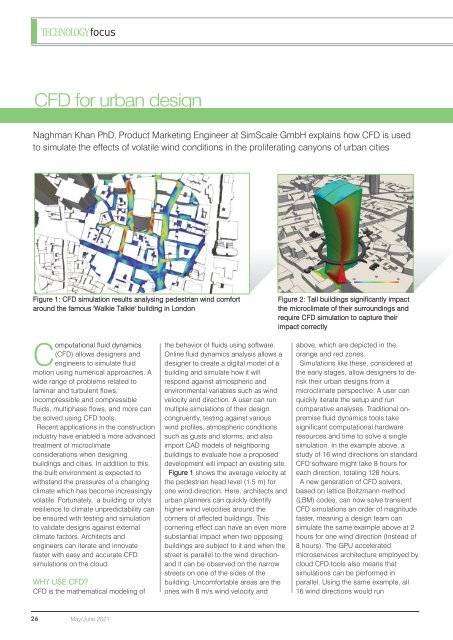CU2105
Create successful ePaper yourself
Turn your PDF publications into a flip-book with our unique Google optimized e-Paper software.
TECHNOLOGYfocus<br />
CFD for urban design<br />
Naghman Khan PhD, Product Marketing Engineer at SimScale GmbH explains how CFD is used<br />
to simulate the effects of volatile wind conditions in the proliferating canyons of urban cities<br />
Figure 1: CFD simulation results analysing pedestrian wind comfort<br />
around the famous 'Walkie Talkie' building in London<br />
Figure 2: Tall buildings significantly impact<br />
the microclimate of their surroundings and<br />
require CFD simulation to capture their<br />
impact correctly<br />
Computational fluid dynamics<br />
(CFD) allows designers and<br />
engineers to simulate fluid<br />
motion using numerical approaches. A<br />
wide range of problems related to<br />
laminar and turbulent flows,<br />
incompressible and compressible<br />
fluids, multiphase flows, and more can<br />
be solved using CFD tools.<br />
Recent applications in the construction<br />
industry have enabled a more advanced<br />
treatment of microclimate<br />
considerations when designing<br />
buildings and cities. In addition to this,<br />
the built environment is expected to<br />
withstand the pressures of a changing<br />
climate which has become increasingly<br />
volatile. Fortunately, a building or city's<br />
resilience to climate unpredictability can<br />
be ensured with testing and simulation<br />
to validate designs against external<br />
climate factors. Architects and<br />
engineers can iterate and innovate<br />
faster with easy and accurate CFD<br />
simulations on the cloud.<br />
WHY USE CFD?<br />
CFD is the mathematical modeling of<br />
the behavior of fluids using software.<br />
Online fluid dynamics analysis allows a<br />
designer to create a digital model of a<br />
building and simulate how it will<br />
respond against atmospheric and<br />
environmental variables such as wind<br />
velocity and direction. A user can run<br />
multiple simulations of their design<br />
congruently, testing against various<br />
wind profiles, atmospheric conditions<br />
such as gusts and storms, and also<br />
import CAD models of neighboring<br />
buildings to evaluate how a proposed<br />
development will impact an existing site.<br />
Figure 1 shows the average velocity at<br />
the pedestrian head level (1.5 m) for<br />
one wind direction. Here, architects and<br />
urban planners can quickly identify<br />
higher wind velocities around the<br />
corners of affected buildings. This<br />
cornering effect can have an even more<br />
substantial impact when two opposing<br />
buildings are subject to it and when the<br />
street is parallel to the wind directionand<br />
it can be observed on the narrow<br />
streets on one of the sides of the<br />
building. Uncomfortable areas are the<br />
ones with 8 m/s wind velocity and<br />
above, which are depicted in the<br />
orange and red zones.<br />
Simulations like these, considered at<br />
the early stages, allow designers to derisk<br />
their urban designs from a<br />
microclimate perspective. A user can<br />
quickly iterate the setup and run<br />
comparative analyses. Traditional onpremise<br />
fluid dynamics tools take<br />
significant computational hardware<br />
resources and time to solve a single<br />
simulation. In the example above, a<br />
study of 16 wind directions on standard<br />
CFD software might take 8 hours for<br />
each direction, totaling 128 hours.<br />
A new generation of CFD solvers,<br />
based on lattice Boltzmann method<br />
(LBM) codes, can now solve transient<br />
CFD simulations an order of magnitude<br />
faster, meaning a design team can<br />
simulate the same example above at 2<br />
hours for one wind direction (Instead of<br />
8 hours). The GPU accelerated<br />
microservices architecture employed by<br />
cloud CFD tools also means that<br />
simulations can be performed in<br />
parallel. Using the same example, all<br />
16 wind directions would run<br />
26<br />
May/June 2021

















